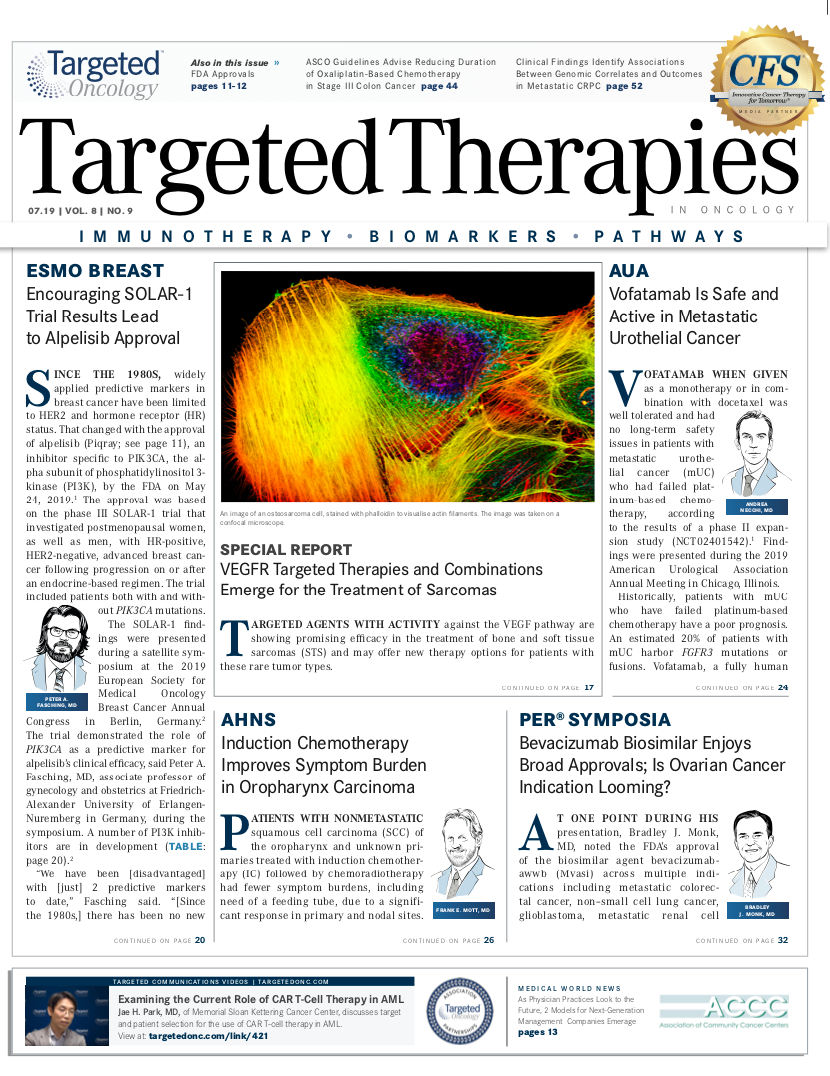Apalutamide Leads to MFS Risk Reduction for Nonmetastatic CRPC
In a posthoc analysis of the phase III SPARTAN trial, lead investigator Julie N. Graff, MD, and colleagues examined the study’s apalutamide (Erleada) arm to determine whether the agent affected metastasis-free survival (MFS), time to metastasis (TTM), and location of metastasis as a function of prostate-specific antigen (PSA) nadir.
Julie N. Graff, MD

Julie N. Graff, MD
In a posthoc analysis of the phase III SPARTAN trial, lead investigator Julie N. Graff, MD, and colleagues examined the study’s apalutamide (Erleada) arm to determine whether the agent affected metastasis-free survival (MFS), time to metastasis (TTM), and location of metastasis as a function of prostate-specific antigen (PSA) nadir. They found that 40% (319 of 806) of patients in that arm achieved a PSA <0.2 ng/mL.1Apalutamide, a potent next-generation androgen receptor inhibitor, prolonged MFS by more than 2 years, according to findings in SPARTAN, a randomized, placebo-controlled study in men with high-risk nonmetastatic castration-resistant prostate cancer (nmCRPC).2
In the analysis, patients in the apalutamide arm who experienced a PSA decline to <0.2 ng/mL had a 76% risk reduction for MFS and TTM compared with patients with no decline. Compared with patients who received placebo, those treated with apalutamide whose PSA declined to <0.2 ng/mL had an 88% risk reduction for MFS and TTM. When metastases developed, depth of PSA decline (to <0.2 ng/mL vs not reaching <0.2 ng/mL) was not associated with location of metastases (bone 53% vs 58%; lymph nodes 27% vs 31%).
“The location of metastases did not differ based on the PSA nadir,” said Graff, associate professor of medicine at Oregon Health & Science University, during a poster presentation at the American Urological Association 2019 Annual Meeting in Chicago, Illinois. “There was no impact on tolerability of apalutamide despite the fact that patients with an undetectable PSA were on the drug longer,” she added.
In SPARTAN, 1207 patients received either apalutamide plus androgen deprivation therapy (ADT; n = 806) or placebo plus ADT (n = 401). The investigators found that apalutamide reduced the risk of metastasis or death by 72% in patients with nmCRPC.
The average baseline PSA doubling time was <5 months in both arms. Patients who developed metastases were allowed to receive abiraterone acetate (Zytiga) plus prednisone.
The primary endpoint of SPARTAN was MFS; secondary endpoints included TTM, progression-free survival (PFS), time to symptomatic progression, and overall survival. The investigators also looked at second progression-free survival (PFS2), defined as the time from randomization until progression on next-line treatment for metastatic CRPC.
Regarding safety, adverse events led to discontinuation in 10.7% and 6.3% of the patients in the apalutamide and placebo arms, respectively. There was no reduction in mean baseline health-related quality-of-life scores in either arm as the trial progressed, nor did the scores differ between the groups over time.
Findings from SPARTAN led to the February 2018 approval of the agent in this setting by the FDA.
The median MFS was 40.5 months in men treated with apalutamide compared with 16.2 months in men who received placebo (HR, 0.28; 95% CI, 0.23-0.35). Also, men in the apalutamide arm demonstrated a 55% risk reduction in symptomatic progression.
The TTM results were similar to the MFS results and signif- icant, Graff reported. Among patients with PSA ≥0.2 ng/mL, those treated with apalutamide had a 56% risk reduction compared with those who received placebo. In patients who received apalutamide, those who experienced a decline in PSA to <0.2 ng/mL had a 76% risk reduction in TTM com- pared with those who did not achieve such a decline.
Among patients who received apalutamide, the median duration of treatment was 20.9 months (range, 0.1-42.0) for those whose PSA was <0.2 ng/mL and 14.7 months (range, 0.1-41.1) for those whose PSA did not reach <0.2 ng/mL. In the placebo group, the median duration of treatment was 11.2 months (range, 0.1-37.1).
In the apalutamide arm, treatment-emergent serious adverse events (TESAEs) were generally similar between patients who achieved a PSA decline to <0.2 ng/mL and those who did not, with TESAEs affecting 72 (23%) and 127 (26%) patients, respectively. In the placebo arm, 92 patients (23%) experienced TESAEs.
Alicia K. Morgans, MD, MPH, a comoderator during the poster presentation, asked, “Would you say that patients who did not achieve that lower PSA nadir would be a population who would benefit from additional therapy? Maybe combination [treatment] with apalutamide could enhance their response and duration of treatment?”
“I think combination therapies may be appropriate. I’m interested in seeing the actual nadir. Maybe if it doesn’t go below 2.0, then the results would be more significant,” Graff replied.
The investigators concluded that apalutamide was superior to placebo with significant reduction in MFS regardless of whether patients achieved PSA <0.2 ng/mL.
References
- Graff JN, Saad F, Hadaschik BA, et al. Metastasis-free survival in nonmetastatic castra- tion-resistant prostate cancer (nmCRPC) patients (pts) with prostate-specific antigen (PSA) decline to < 0.2 ng/mL following apalutamide (APA) treatment: post hoc results from the phase 3 SPARTAN study. Presented at: American Urologic Association 2019 Annual Meeting; May 3-6, 2019; Chicago, IL. bit.ly/2Xiilhy.
- Small EJ, Saad F, Chowdhury S, et al. SPARTAN, a phase 3 double-blind, randomized study of apalutamide (APA) versus placebo (PBO) in patients (pts) with nonmetastatic castration- resistant prostate cancer (nmCRPC).J Clin Oncol. 2018;36(suppl 6, abstr 161). doi: 10.1200/ JCO.2018.36.6_suppl.161.

Biomarker Testing Paves the Way for Better Targeted Therapies in NSCLC
April 16th 2024At a live virtual event, Edward S. Kim, MD, MBA, discussed the evolving landscape of biomarker testing before making treatment decisions for patients with early-stage non–small cell lung cancer (NSCLC).
Read More